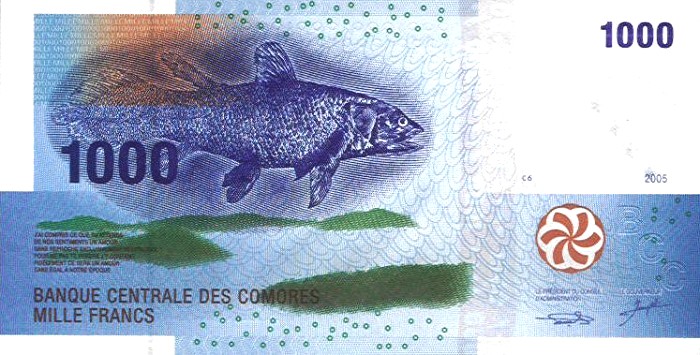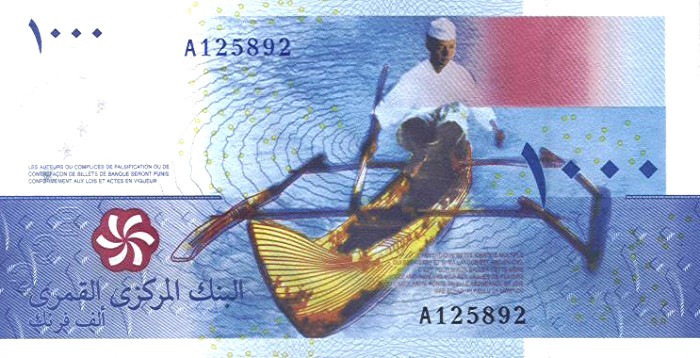The International Bank Note Society (IBNS) has just given the Bank Note of the Year award to the Banque Centrale des Comoros for their 1,000-franc note issued in 2006.
The IBNS Bank Note of the Year is awarded to the banknote which, in the eyes of the judges, has a high level of artistic merit, an imaginative design, and features that present the best of modern security printing (taking into account the value of the note). The Comoran 1,000-franc note impressed the judges with innovative design, well-balanced color, and sensible use of modern security features.
Here is the best part, in my opinion:
Poetry is common to the entire series of notes to which the 1,000 franc belongs, with a verse appearing on the front and the back of each note. The verse on the front of the 1,000-franc note can be translated from French as:
From our feelings, what you expect I understood
For it is a love that is so absolutely exclusive
That, not to lose you, I hereby consent.
Truthfully, it will be a love
That our times have never seen.Continued on the back of the note is a further verse which translates as:
I claim these different names which are ours
and if I speak the rainbow
It is to better greet our Indian Ocean sea-mother
whose waves of pleasures brings
to insularity abundance and joyThe final line below the verse identifies the author, Mab Elhad, and the book in which his verse appears: Kaulu la Mwando (meaning First Word in the Comoran language). The book was published in 2004 and the verses of the author, a Comoran policeman, celebrate his Comoran life and nationality.
And then there are the security features:
Despite a low face value (approximately US$2.70 at current exchange rates), the 1,000-franc note sports an impressive array of security features. Portions of the design are printed with the intaglio process, imparting a tactile element to the raised ink, along with the latent image created by the BCC embossed above the signatures. Counterfeiting is made more difficult through the use of microtext, incorporation of a perfect-registration device, and the inclusion of Omron rings. The paper contains an embedded security strip that fluoresces under UV light, and a watermark of a crescent moon, four stars, and the letters BCC. Finally there is an iridescent band on the front of the note that can be seen only when tilting the note at an angle to the light.
Impressive indeed. Is it possible for the bill value to go higher due to the Bank Note of the Year award coupled with the high-tech security features? Clearly smaller circulation countries have an advantage as they can be more nimble with their designs and adoption of new technology. Large networks of legacy ATMs, for example, will probably never need to read Comorian denominations. But the “series of notes” comment is not lost on me.
It does not make a lot of sense (pun not intended) for currency in America to be so tired and stagnant while innovation abounds elsewhere in the world. From a national pride let alone security perspective the dollar series has been flat. Strange that credit cards can be issued in a million colors and patterns yet the new currency in America has barely changed in 60 years. With the life of an actual dollar bill of less than two years, one would think there could be more variety in the series.

